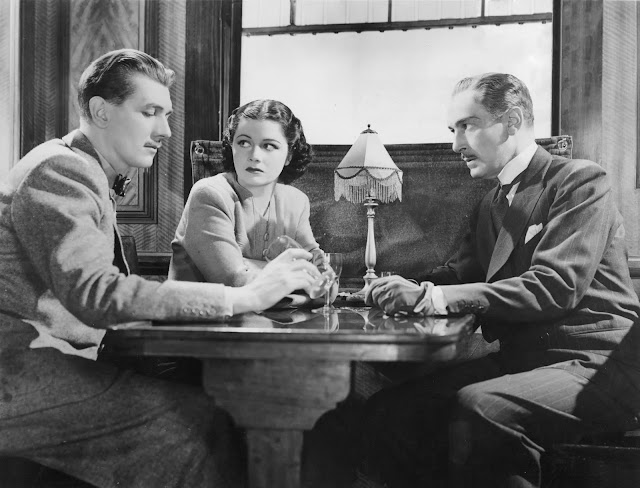The Lady Vanishes (1938)
Alfred Hitchcock's "The Lady Vanishes"
The film that got Hitchcock to Hollywood, 1938's "The Lady Vanishes," is perhaps the ignition point for the "Hitchcockian" films we've come to expect from the master. It is considered one of the best British films of the 20th century. It also caught the attention of Hollywood producer David O. Selznick, who believed Hitchcock would be a perfect addition to the Hollywood directorial roster at his production company. "The Lady Vanishes" was based on a 1936 mystery novel called "The Wheel Spins" by Ethel Line White. It was adapted to the screen by Sidney Gilliat and Frank Launder with additions to the story by Hitchcock.
Most of the film takes place entirely within a train car on its way to England from the fictional country of Bandrika. An English tourist named Iris Henderson is returning home to marry her wealthy fiance. After a vase is knocked over from a 2nd story window onto her the back of her head, she is helped onto the train by a middle-aged English woman named Miss Froy, who claims to be a governess. After the two incidentally interact with various train car passengers, Miss Froy sits besides Iris as she sleeps. When Iris awakens, Miss Froy has vanished. Even more mysteriously, nobody on the train seems to remember the woman ever being there at all. Was Iris just hallucinating Miss Froy after her head injury? It does not appear that way, as Iris enlists a male passenger to help her track down the missing woman. Along the way, they get entangled in a conspiracy of international espionage.
Although not overtly political, "The Lady Vanishes" contains subtext of political commentary. Miss Froy is attempting to smuggle international secrets out of the fictional country of Bandrika, which seems to resemble a contemporary 1938 fascist Italy. After being abducted, Iris enlists the help of her fellow British passengers to aide in her recovery. However, all the other British passengers all have selfish reasons for not wanting to engage, as none of them want to cause a scene and risk prolonging their ride back home. The film seems to be suggesting that a contemporary Britain does not want to get involved in the political stakes the rest of Europe is involved with. However, after the antagonist derails the train car, causing it to stop just before they reach the border, armed men appearing as government officials engage in a shootout with the car passengers. Thus, it seems to suggest that Britain, despite its reluctance to get involved with European power struggles, will undoubtedly be dragged into conflict (which does come to fruition several years later).
However, much of the political commentary made it past the censors, as much of the story involves a suspenseful search for a missing woman, and the intrigue it follows. On the surface, "The Lady Vanishes" is a through-and-through mystery thriller, aimed at commercial viabilities and audience engagement. Which is certainly succeed at. With the film, Hitchcock demonstrated his mastery of the suspense and mystery elements of the film, creating layer after layer of visual cues, motifs, and MacGuffins. He makes it aware to the viewer that Iris is not crazy from the very beginning, as he visually shows us a set of hands pushing over the vase intending to land on Miss Froy's head, and instead hitting Iris. Throughout the film, he continuously shows us images the character do not see, creating inherent suspense. For example, Iris and her male companion, Gilbert, are unaware Dr. Hartz is the antagonist for several minutes, as the audience sees Dr. Hartz spike their drinks. For the next couple of minutes, we are held in suspense as Hitchcock keeps in the drinks in frame, as Iris and Gilbert are unaware of their danger. The continuous mystery and unraveling of the story keeps the viewers engaged and in a state of suspense.
Hitchcock came to be known "The Master of Suspense" later in his career and for good reason. However, it was "The Lady Vanishes" that ignited this concept, and allowed him to move to Hollywood where his legend and craft grew.
Writer Assessment: Although not something I would consider a masterpiece, "The Lady Vanishes" is a fantastic mystery thriller. The first twenty minutes of the film is purely exposition, as we get to know all of the characters and their intentions. When Iris begins to search for the missing lady, I too became engaged in the mystery of it all, knowing full well Iris was not crazy. I was super interested in the conspiratorial nature of what I was seeing. It also seemed to be incredibly "Hitchcockian" in that an everyday normal person becomes intertwined with a mystery that, as they continue to unravel, only intertwines them more and more with something not only bigger than themselves, but fateful to global order in itself. Hitchcock seems to be drawn to the idea that there is a world of intrigue just under the surface of the everyday occurrences happening around us. The fate of global order is happening just under our noses and the purest thrill of suspense entertainment is taking an everyday mundane citizen (like the viewer) and letting them go down the rabbit hole of conspiracy and intrigue. It certainly was an enjoyable viewing experience.




Comments
Post a Comment